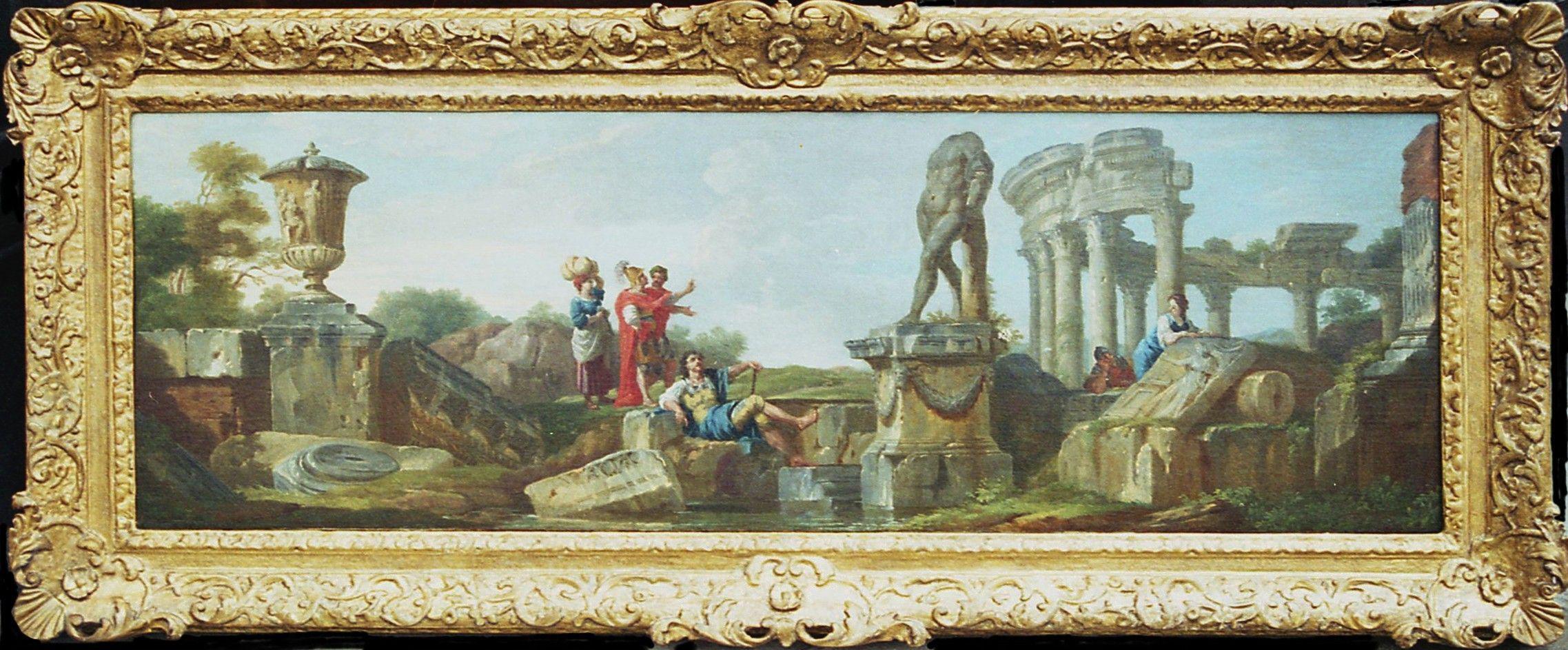"Gaius Marius sitting as a fugitive among the ruins of Carthage", Plutarch
"Gaius Marius sitting as a fugitive among the ruins of Carthage", Plutarch
Workshop of GIOVANNI PAOLO PANINI
1691-1765
Italian School
“Gaius Marius sitting as a fugitive among the ruins of Carthage”, Plutarch
Oil on canvas
40 x 122.2 cms
15 3/4 x 48 1/8 inches
In Piacenza Panini probably worked with the architectural painters F Bibiena and G Natali and was influenced by the landscape painter Ghisolfi. After a move to Rome in 1711 he attended the drawing academy of the figure painter Benedetto Luti until c. 1718.
After a period of concentrating mainly on architecture, fresco painting and designing festivities, Panini turned to the vedute and capricci for which he became famous. In Rome he was influenced by Andrew Locatelli’s landscapes and Sebastiano Conca’s figures. He married the sister-in-law of Nicolas Vleughels, director of the French Academy in Rome, became a teacher of perspective at the Academy and was much patronised by the French community in the city. His work was an influence on Joseph Vernet and Hubert Robert.
GAIUS MARIUS 157 - 86 BC
Marius was a provincial Italian who made his way on his abilities rather than through connections. He reorganised the Roman army on a semi-professional basis and all citizens, whether rich or poor, could join it. He improved training and equipment and as a result of the heavy backpacks his troops were required to carry, they were known as Marius’s mules.
As a Roman general he had a distinguished military career starting with his early success at Numantia in 134 BC. He became a a tribune in 119 BC and then served in Africa against Jugurtha, King of Numidia and as consul ended it in 106 BC. Meanwhile, an immense horde of Cimbri and Teutons had burst into Gaul and repeatedly defeated the Roman forces. Marius annihilated them in a terrible two day battle near Aix in Provence where 100,000 Teutons were slain. He then turned his attention to the Cimbri in Northern Italy and crushed them near Vercellae in 101 BC.
He was elected to five consulships between 104 and 101 BC on the strength of his military prowess, declared a saviour of the state and named the third founder the Rome followed by his sixth consulship in 100 BC.
Marius allied himself with the extreme democrats in Rome and consequently came into direct conflict with the new consul Lucius Cornelius Sulla, a general and leader of the aristocratic conservative party who wanted to create a more centrist and autocratic government. When Sulla was entrusted with the conduct of the Mithridatic war, Marius became insanely jealous of his rival and attempted to deprive him of his command.
Civil war ensued in 88 BC and Marius was soon forced to flee and after frightful hardships and hairbreadth escapes through the Pontine marshes made his way to Libya. He remained there until a rising of allies and friends under Cinna allowed a return to Italy. With Cinna he marched to Rome forcing it to yield. His forces exacted a brutal revenge on the aristocracy and 4000 slaves carried on the work of murder for five days. Marius and Cinna were elected dual consuls for the year 86 BC but Marius died a fortnight after the election.
This painting shows the scene, described in the “Life of Marius” by the Greek Historian Plutarch, where the Roman general, upon his arrival in Libya, is informed by a messenger from the governor that he is forbidden to land. Marius then replies “Tell your master that you have seen Gaius Marius sitting as a fugitive among the ruins of Carthage”.
1691 - 1765
Oil on canvas
Italy
RELATED ITEMS























